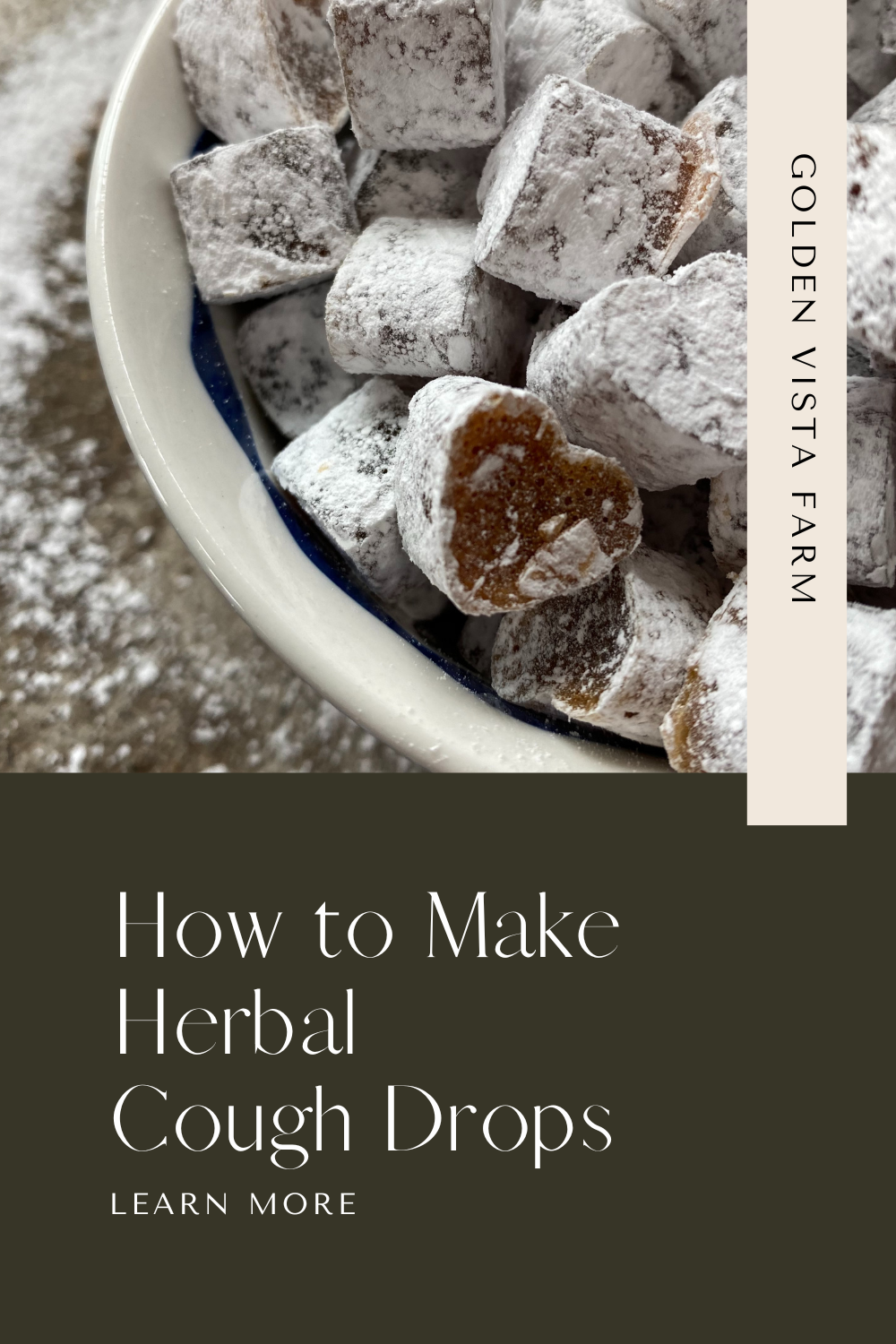Herbal Cough Drops
Ready to have some more herbal fun and create your own handcrafted cough drops? And honestly—it’s really not all that hard! So come on, let’s get making!
What type of cough do you have?
The type of cough you have really does matter! It will help you decide which herbs are best to use for the type of cough you have which will make the cough drops more effective. Unfortunately in our world most we tend to think in terms of “what herb is good for such and such” which is a one size fits all approach. A better more holistic way of looking at it would be to look at the type of cough (such as dry or moist) and to also consider the “constitution” of the person taking the herbs. It’s all very fascinating and I love looking at herbs from this angle. I won’t get into it all today, but if you are curious about this more holistic approach I encourage you to look up Ayurveda.
With all that being said, I have some herbs listed at the bottom of this post that you can pick and choose from to help match the type of cough you’re addressing. I would also like to note that generally speaking coughing is the way your body is expelling excess mucus. Unless the cough is really bothersome, you aren’t able to sleep, or some such reason, it really is okay to let your body cough and try to get the crap out. But again, there is a time and a place for cough drops, so here’s the recipe for those times!
Herbal Cough Drops
Ingredients
1 ounce of dried herbs (choose from the list below)
1 cup of water
1 cup organic cane sugar
1/2 honey
5-10 drops essential oils (optional—ideas below)
Candy thermometer
Heavy saucepan
Candy molds (or make your own molds—directions below)
Directions
If you choose all hard herbs (roots, bark, berries, etc.) then go ahead and make a decoction by bringing the herbs and water to a boil. The reduce the heat and gently simmer for 20-30 minutes. If you also have softer herbs such as leaves and flowers, add those in for the last 5-10 minutes of the simmer.
Once the water has been reduced to about half the original amount, turn off the heat and carefully strain off the herbs. If you don’t have quite 1/2 cup of liquid, it’s perfectly okay to add a teensy bit of water.
Pour the herbal liquid back into the pot (rinse it out first) and add in the sugar and honey. Bring the mixture up to a boil and stir until all the sugar is dissolved. Reduce the heat to about medium to medium high heat and continue cooking
What we want now is for the mixture to reach hard crack stage which is 300°F. So clip a candy thermometer to the side of the pan and stir occasionally while it continues to bubble away. While you wait you can prepare your candy molds—just don’t leave the room, as it doesn’t take much for the candy to scorch! If you start to smell it burning, immediately take it off the heat. And next time—don’t cook it at such a high heat.
Preparing candy molds
White you’re waiting for the candy to hit that sweet spot of 300°F, check out this fun way of making your own candy molds.
Get out a 9 X 13 pan, dump a bunch of powdered sugar in it and poke small holes into the sugar. I use a little lid of some sort—usually from a mister bottle. You could also just use your finger if you wish. So basically you’re making little wells which is where you’ll pour the hot candy when it’s ready.
Now back to the candy
Yay—it hit 300°F finally! Remove the hot sticky mess from the heat and VERY carefully pour it into your little well indents. I use a spoon. Probably much safer for my klutzy self. Once I fill the pan, the first cough drops are usually pretty hard, so I sprinkle the tops with powdered sugar and then take them out of the pan, setting them on a plate to continue to harden.
Continue to make more wells and fill with more cough drops until you’ve used up all the mixture. You will want to move as quickly as you can as the mixture will start to harden on you.
how to store the cough drops
I like to freeze these in a single layer on a cookie sheet and then transfer them to an airtight container. Otherwise you can also try storing them in the fridge, but they may end up melting together slightly.
Herbs to use
This is by no means an exhaustive list, but should give you a place to start. I would definitely consider the flavor as you’re choosing the herbs. One of my favorite combos is cherry bark, orange peel, ginger root, and sweet orange essential oil. Not only is it a great cough combo, but it tastes pretty amazing!
Also—before choosing any herbs for these cough drops please do your own research for safety. Some of these herbs, for example, are not recommended if you are pregnant or nursing.
Cherry Bark (wild)
Wild cherry bark has expectorant, antitussive (cough relieving), astringent, antispasmodic, anti-inflammatory, and nervine actions. This makes it incredibly useful for coughs, especially those with excess mucus.
Ginger
Ginger is a very soothing herb and as an antiinflammatory and antimicrobial and can be helpful to calming down a “tickle” in the throat. In Ayurveda ginger is known as the universal medicine.
Horehound
Horehound is useful for spastic coughs and sore throats due to its antispasmodic and pain relieving properties.
Hyssop
Hyssop is considered a warming herb that is useful in helping expel excess mucus.
Olive leaf
Antimicrobial and antiviral properties of olive leaf make it useful for the immune system.
Peppermint
Peppermint contains menthol which can be useful in relieving coughs by inhibiting the nerves that react to painful stimuli.
Sage
Antiseptic and astringent, sage is great for soothing swollen tissue.
Thyme
Thyme is very helpful to the lungs and can help loosen phlegm and open up the bronchioles. It is antiviral and antibacterial.
White Pine (and other pine species)
The needles of the white pine tree can be useful for relieving a deep barking cough. It can soothe a sore throat while thinning congested mucus.
Yarrow
Yarrow can be useful to a cough especially when a sore throat is present. It is known to help soothe and fight off the common cold. It is antiseptic, antimicrobial, and a relaxing diaphoretic.
Essential oils
As far as essential oils go, I would put these in more for flavor than anything else. I personally don’t recommend using essential oils internally unless for culinary purposes or under the direction of a trained aromatherapist.
If you choose to add in essential oils, be sure you are using high quality, organic oils. And just like with the herbs, be sure to do your own research to make sure these are safe for you.
A few delicious options would be:
Lemon
Sweet orange
Grapefruit
Lavender
Cinnamon leaf (be sure to use the minimum amount suggested—cinnamon can be highly irritating!)
Clove (Also use the minimum amount suggested—same as cinnamon)
Peppermint (Same as cinnamon and clove)
WHERE TO PURCHASE
I appreciate you taking the time to read my blog! By purchasing through one of my affiliate links you will not spend a penny more, but you are allowing me to receive a small commission. This allows me to keep posting great content for you. Thanks for your support! Read more here.
If you are unable to grow your own herbs, or find ingredients locally, then here are two of my favorite places to buy bulk ingredients:
This company is where I purchase the majority of my seeds. Great selection of heirloom and/or organic seeds:
This is my favorite essential oil company that is reasonably priced with organic and wildcrafted oils





















